
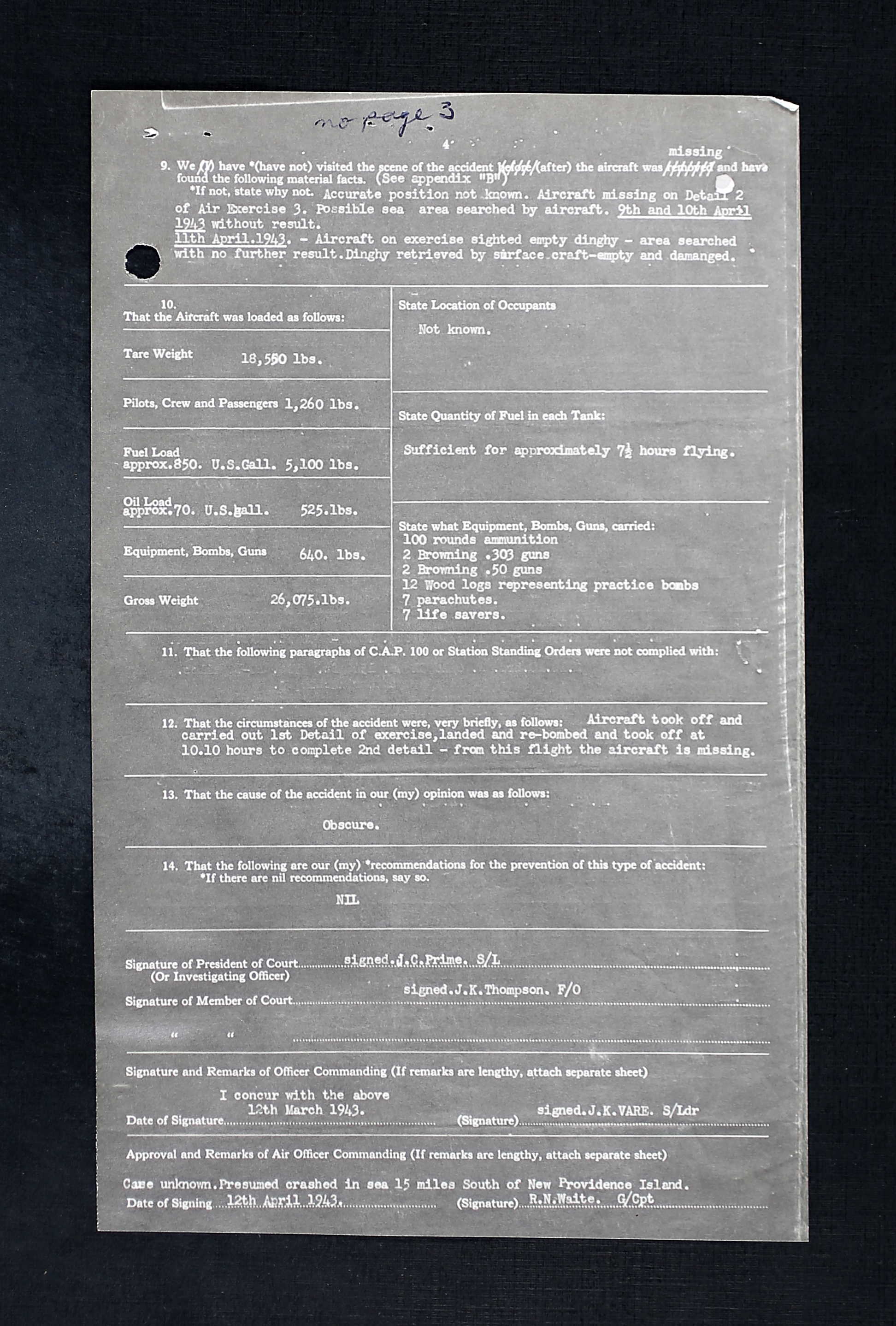

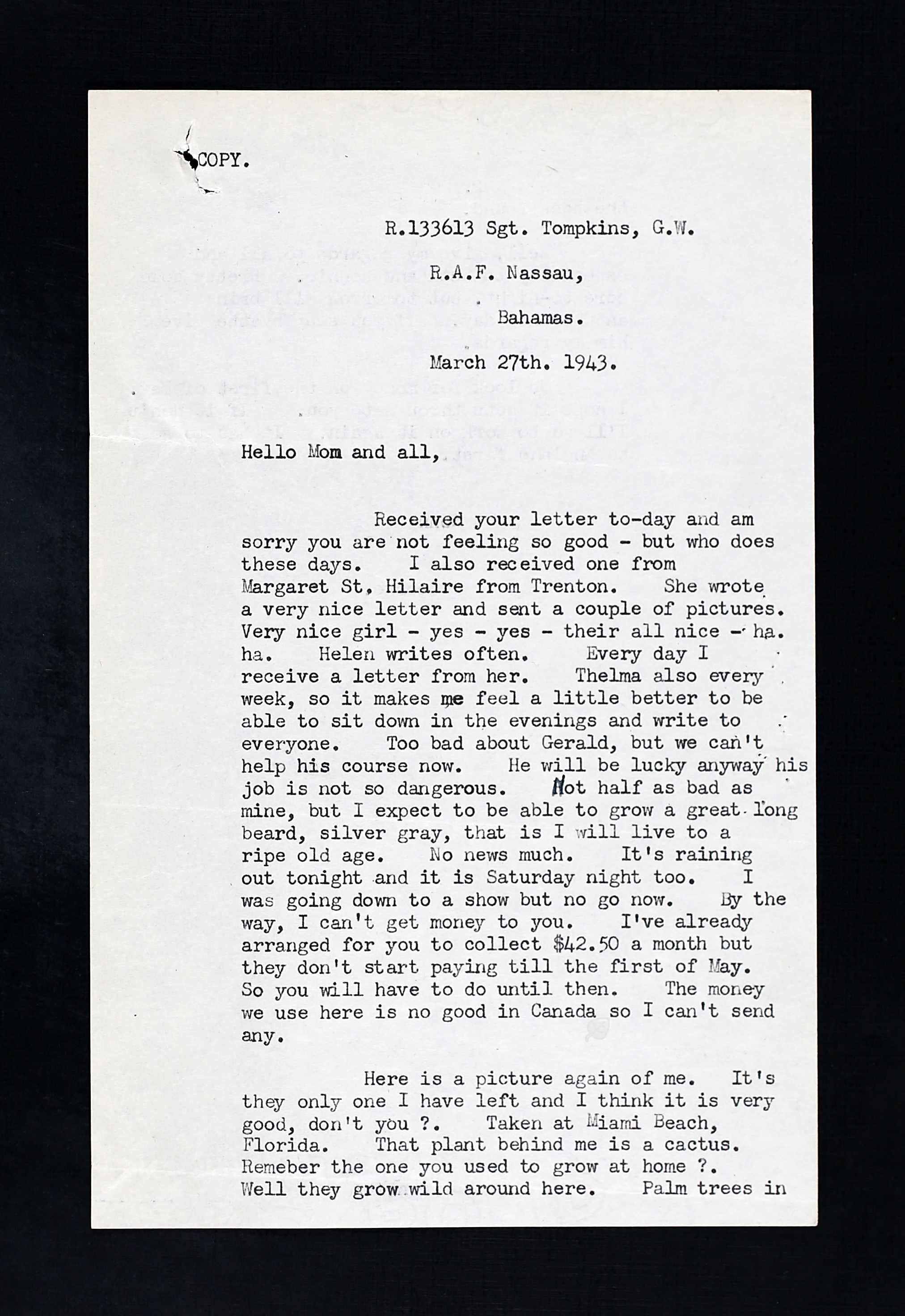
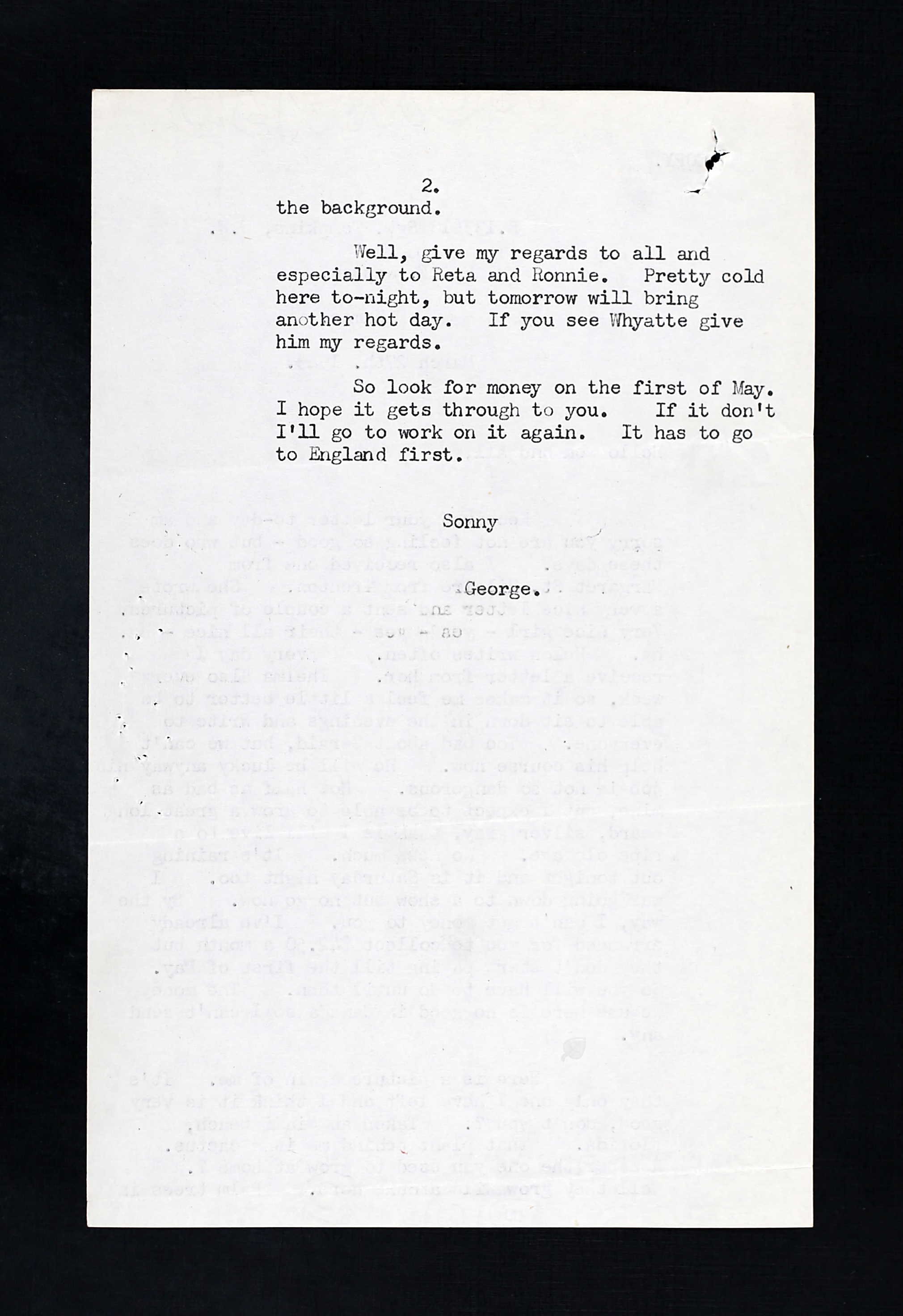
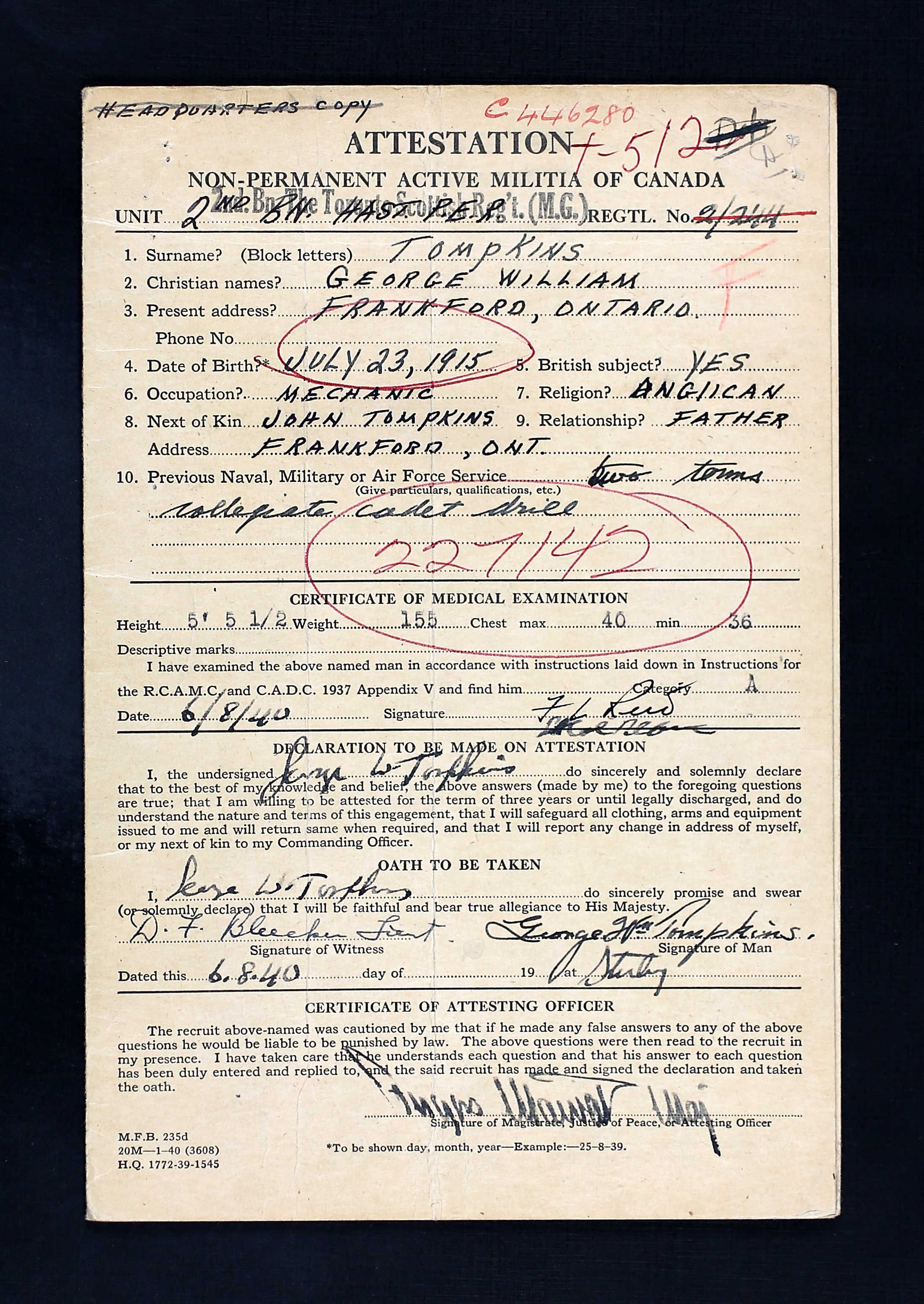
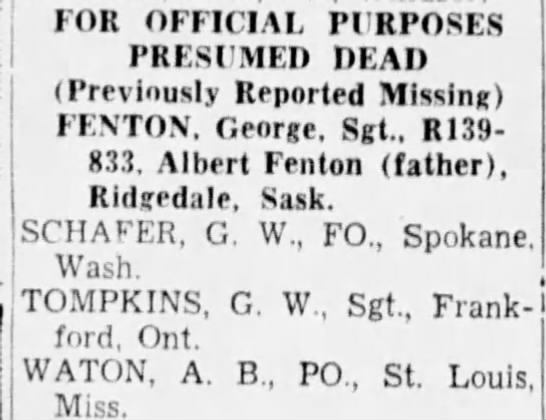
July 23, 1915 - April 9, 1943







George William Tompkins was the son of John Delos Tompkins, farmer and auto mechanic, and Florence (nee Gardiner) Tompkins of Frankford, Ontario. He had three brothers, Gerald Clifford, William Henry (d. 1933) and Charlie G. (d. 1907 as a baby). He had five sisters: Mable, Eva, Marjorie, Reta and Mary. The family was Presbyterian. (On another document, the family was Anglican or United Church, and George had only one surviving brother.)
George worked at for two seasons as a cheese company, at $40/month, then Bata Shoe Co. in Brantford from June 1939 to October 1941 earning $50/month, then at Central Steel, Trenton, as a machinist earning $120/month, worked at Canadian Canners in maintenance for six years (seasonal), then a clerk at T. Eaton Co. in Toronto earning $70/month, prior to enlisting with the RCAF. He indicated that making cheese was long and hard work, the “heat very intense.” At the steel assembly plant: “is heavy work and long hours! Cold!” Survey and road building: cold and wet. Electric: “Very dangerous and heavy. I received a shock of 550V and burns.”
He was also a member of the NPAM as of August 6, 1940. He stood 5’ 5 ½” tall, weighing 155 pounds. He was taking math, physics, algebra, and English at U of T for enlisting in the RCAF and felt he was progressing very well. He liked art, geography, and history best, arithmetic and algebra the least. He had no outlook for future employment prior to the outbreak of war. He had been seriously interested in aviation for six years, reading plenty. He had applied to the RCAF in June 1934 and then again in February 1941. He hoped to be a pilot or observer. He had driven a car 20,000 miles in 1941, “previous years much more. Transport driver also. Lived by the river and swam often in summer months. Fishing excellent pastime and enjoy it. High score shooting in army and in civilian life; often went hunting.” He wrote, “I have always had a desire to be a member of an Aircrew and until proven otherwise, will persist.” He wanted to be a bomber pilot. He felt he was steady and persistent. He smoked five cigarettes a day and drank beer rarely. A ¾” scar on his right upper forehead was noted. He had brown eyes and brown hair. By the time he was with the RCAF, he stood 5’ 7 ¼” and weighed 159 pounds.
On his medical form, he had eight carious teeth. “Alert, bright, solid, stable candidate. Muscular physique, low average intelligence; reacts slowly but very determined. Coordination fair. Will require extra effort.” Other comments: “A well-developed lad, good reactions, intelligent, pleasant, eager, co-operation. Carious teeth unsatisfactory.” More comments: “Wants pilot of observer. Alert, stable, lacks education; slow reactions, mentally rather lethargic but very determined. May make pilot with hard work.”
On the RCAF Interview Report: “Machinist and motor mechanic experience. Sport: Wrestling, swimming, and baseball. Hobby: Shooting. Good average type, keen and intelligent, should be able to absorb instruction and make good Aircrew material. Likes shooting.” George noted that he liked to try to fix radios as a hobby. “Spending all the time I could get in civilian life to accomplish this.” He liked going to movies and dancing usually two nights a week or more if possible.” His favourite actor was Robert Taylor and his favourite musician was Guy Lombardo.
George started his journey through the BCATP at No. 1 Manning Depot, Toronto. While here, on October 2, 1941, he made a will with his mother as sole beneficiary then was at No. 1 ITS, Toronto, from December 22, 1941 until February 14, 1942. “75th out of 84 in class. 65%. Link trainer: 86%. Easy going average type with good application, but finds it difficult to grasp the academic work. Obtained 101 in Navigation Suppl. Second Aircrew recommendation: WOAG.” George was in the station hospital December 2, 1941.
He was sent to No. 4 BGS, Fingal from October 28 to November 11, 1941, then to No. 1 SFTS Camp Borden until there was room for him to start pilot training.
He was at No. 9 EFTS, St. Catharines, Ontario, from February 16 to April 10, 1942. “FLYING TRAINING: 75%. Above average. Above the average in clear-hood flying; average in other phases of his flying. Instrument flying would require more practice to come up to the high standard that he has attained in clear-hood flying.” GROUND TRAINING: “27th out of 33 in class. FAIL. This man is very keen to continue and secure any other opportunity for service pilot training. His training has been discontinued for failure to pass ground school. Remustering to WAG; conduct and deportment very good.” George was sent to KTS, Trenton.
At No. 4 Wireless School, Guelph, Ontario, from June 8, 1942 to December 21, 1941: “100th out of 105 in class. 68.6%. Average.” At No. 5 BGS, Mountainview, Ontariio, from December 29, 1942 to January 25, 1943: “24th out of 30 in class. This airman’s air flying results were below average.” FINAL ASSESSMENT: “20th out of 30 in class. This airman is steady and reliable. He is not outstanding in any way but has worked hard on his course and seems to have mastered the work. He should make an excellent NCO.” He was again in the hospital from December 16-19, 1942.
George, now a WOAG, was sent to EAC Halifax February 16, 1943, then to No. 31 P. D. Moncton, NB, then to 111 O.T.U. Nassau, Bahamas.
On March 27, 1943, he wrote a letter home: “Hello Mom and all, received your letter today and I'm sorry you are not feeling so good, but who does these days. I also received one from Margaret St Hilaire from Trenton. She wrote a very nice letter and sent a couple of pictures. Very nice girl -- yes -- yes -- their [sic] all nice -- ha ha. Helen writes often. Every day I receive a letter from her. Thelma also every week, so it makes me feel a little better to be able to sit down in the evenings and right to everyone. too bad about Gerald, but we can't help his course now period he will be lucky anyway his job is not so dangerous. Not half as bad as mine, but I expect to be able to grow a great long beard, silver grey, that is I will live to a ripe old age. No news much. It's raining out tonight and into Saturday night too. I was going down to a show but no go now. By the way, I can't get money to you. I've already arranged for you to collect $42.50 a month but they don't start paying until the 1st of May. So you will have to do until then. The money we use here is no good in Canada so I can't send any period here is a picture again of me. It's the only one I have left and I think it is very good don't you? Taken at Miami Beach, Florida. That plant behind me is a cactus. Remember the one you used to grow at home? While they grow wild around here. Palm trees in the background. Well, give my regards to all and especially to Rita and Ronnie. Pretty cold here tonight, but tomorrow will bring another hot day. If you see Wyatt give him my regards. So look for money on the 1st of May. I hope it gets through to you. If it don't [sic], I'll go to work on it again. It has to go to England first. Sonny/George”
On April 9, 1943, Mitchell FR379 took off from Nassau, Bahamas on a training flight that had two exercises, the aircraft and crew completed the first exercise and returned to base for refuel and re-arm. Aircraft took off for the second exercise and went missing, search was conducted, but nothing was found. Cause of crash and location is not known, aircraft and crew missing without a trace. A court of inquiry was called with five witnesses. Cause of accident: Obscure. The aircraft had enough fuel for 7 ½ hours of flying. Two days later, aircraft on training mission spotted a dinghy; surface craft recovered it, empty, and damaged.
Crew: *Pilot: F/O G.W. Schafer, C/6035, RCAF, Spokane, Washington *Pilot: P/O A.B. Waton, J/20590, RCAF, St. Louis, Missouri, U.S.A. *Nav: P/O B.B. Goodman, J/21746, RCAF, Carman, Manitoba *Wop/Gnr: Sgt G. Fenton, R/139833, RCAF, Ridgedale, Saskatchewan, Canada *Wop/Gnr: Sgt G.W. Tomkins, R/133613, RCAF, Frankford, Ontario, Canada *Wop/Gnr: Sgt L.R. Burchell, R/124720, RCAF, Glace Bay, Nova Scotia *Wop/Gnr: Sgt R. Farnsworth, 578225, RAFVR, Witton Gilbert, Co. Durham, United Kingdom
On April 24, 1943, Mr. Tompkins wrote that he was next of kin making application for his assigned pay and personal effects due him. “Hoping to receive news thru Ottawa that he is still alive.”
On May 19, 1943, a letter written by Mrs. Tompkins requested information if she would receive any pension or allowance as the result of her son’s death in the Bahamas. “My son advised me he was leaving his allowance on the first of May and back pay. As he acquainted with our family needs and knew I was the only one to whom he wished any means to go to. And I live alone. And I am in need of any means that would be allowed. Please advise me who to write to and would like to have to see what you can do about it.”
August 31, 1943, Mrs. Tompkins wrote a letter to the Dependents Allowance Board requesting information about George’s will and that she was in need of help.
November 8, 1943, Mrs. Tompkins wrote another letter this time to the RAF Authorities in Nassau. “Enclosed you will find my son’s letter which he made his will to me. I have raised seven children and had no help. My son, George, is now gone who gave his life for us all. I should have his allowance, which he has written in his letter. I had a copy printed off of his letter which he wrote to me. The letter speaks for itself and will make the matter clear to you and would like you to see what they can do for me and oblige, his Mother.”
On January 22, 1944, Mr. Tompkins wrote that he had had no word from his son, nor knew the whereabouts “only wishing I did, but I am only too afraid he is gone with many others of his rank.”
In April 18, 1944, Mrs. Tompkins wrote the the Canadian Pension Commission. “In a letter from our Canadian Government at Ottawa, I am advised of the official recognition of the death of my son…I am therefore hereby making application to have his personal effects sent to me as soon as possible.”
On September 12, 1945, Mr. Tompkins indicated that he was never a dependent upon George but wanted to act as one who was authorized to act on behalf of the service estate of his late son.
The Estates Branch received a letter written December 6, 1945 from Robert H. Smithrim, barrister for Mr. Tompkins. “Mr. Tompkins informs me that prior to his son’s enlistment, his son was a dependent of him. On enlistment, his son made an assignment of pay to his aunt, Margaret Uber, who, I believe, lives in Toronto, but this was not made to her as a dependent as she is in a good financial position. Since Mr. Tompkins knows of no will having been made by his son, it would appear that only the will left by [him] would be the will made on enlistment with the Air Force. If such a will is in your possession, will you kindly forward same to this office…I might add that Mr. J. D. Tompkins is at present living in Trenton at his work at the RCAF Station, Trenton, jakes it difficult to reside at his actual home in Frankford where his wife is living. He and his wife are, however, on good terms and the fact that they are living in different accommodations a major share of tie is simply because Mr. Tompkins’s work is at Trenton and his wife prefers to live in Frankford.”
Mrs. Tompkins received a letter in late October 1955 informing her that since her son had no known grave, George’s name would appear on the Ottawa Memorial.